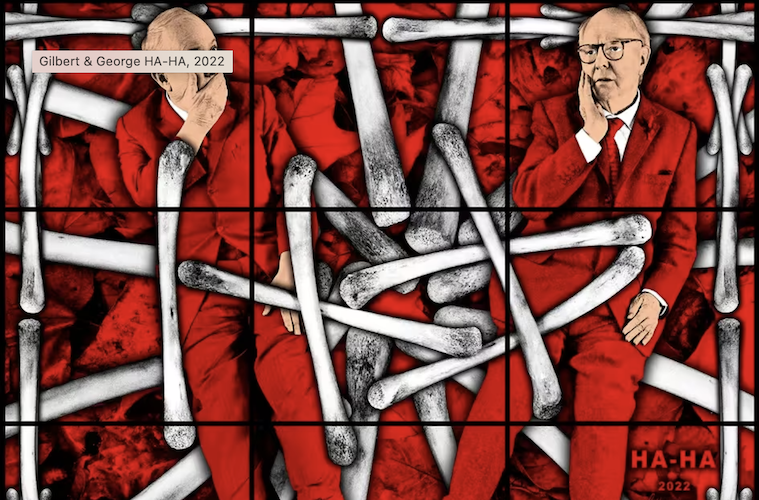Well, here we are again. A bit like meeting your boozed up, aged uncle from the Home Counties – colourful and confrontational as always, but rather stuck in his ways.
I have been to many Gilbert and George exhibitions over the years and watched as “the two people, one artist” became a venerable national institution. They tend to riff on particular topics at particular times – those they believe drive our human activity and interest – sex, money, religion, patriotism, hope, fear, death – but within a distinctively contemporary urban frame, and a uniquely London one.
The latest show has opened at the Hayward Gallery on Waterloo’s South bank to some fanfare and many five-star reviews. It is a retrospective of their art during this century and includes over 60 large-sized pieces, with pictures grouped not in chronological order but rather around certain themes such as “personal identity” and “media”.
The pair’s work is often deliberately provocative, using sexual images, crude words, crass newspaper headlines and scatological humour, typically set within large, brightly coloured panels imitating the stain glass windows in churches. As the light shifts and changes, these create a sacred and almost worshipful atmosphere. As you gaze up, much as you would at a rose window in a cathedral or abbey, you can’t help but search for some kind of deeper meaning, but the thing remains elusive and perhaps is never really there at all.
Born in the 1940s George (Passmore, in Plymouth) and Gilbert (Prousch, in South Tyrol, northern Italy), met at St Martins school of art where they studied sculpture. Swept up by the spirit of 1967, the embracing and celebrating of the experimental and performative, they became “singing sculptures”.
In their trademark conventional suits and with their heads painted a metallic grey, they would stand on a table, moving in slow motion as they sang Flanagan and Allen’s old-time music-hall hit Underneath the Arches, often for hours on end. Promoted by renowned art dealers, they travelled the world as living sculptures, gaining a widespread following which opened doors for selling their later drawings and paintings.
Yet Gilbert and George like to play the outsiders, claiming they reject the art and the teaching of the time they were students. They sought to create an art that addressed the thoughts and feelings of people from all over the world – work that spoke to people in general, not just those who understood the language of art appreciation. Its purpose was to reflect and trigger an emotional response – to reach out. Art for all, they claimed. They wanted to make audiences go home from their exhibitions feeling a bit different. Hence their attempts at provocation, which even today some find offensive, but can more often seem outdated.
London fascinated them, with all its contrasts and energy. They moved into Fournier Street in Spitalfields in 1968 because it was cheap and unloved. They were among the first to restore an old Huguenot silk weaver’s house. The East End became a formative influence on their practice and, as they wandered, so they collected the detritus of urban life to include in their work – physical things like old bones, sticks and leaves, but also images of graffiti, calling cards of male sex workers, faces of people they met.
With room after room to explore at the Hayward, you are bound to find pieces that will draw you in. My particular favourite was Life After Death Proven, a challenging thought for a humdrum day, which includes two old world means of communicating – a red post box and a red telephone box framing a London bus, its passengers lost in their own worlds, heads down on phones or lost to the sounds coming from their headphones. Together but alone.
Yet the very size of the works, often set side by side with little space between, can be overpowering. Maybe they are making a point about the rush and flurry of images we navigate in our daily lives. But the juxtaposition of so many pieces amplifies the repetitive nature of their format, and the imagery can often seem tired and less urgent than it did in the last century. Perhaps it has become a bit passé and it’s the personalities that keep the machine whirring now.
Follow Richard Derecki on Bluesky. The Gilbert & George 21st Century Pictures exhibition will run until 11 January, 2026. Image: Ha-Ha (2022) from Southbank Centre website.
OnLondon.co.uk provides unique coverage of the capital’s politics, development and culture with no paywall and no ads. Nearly all its income comes from individual supporters. For £5 a month or £50 a year they receive in-depth newsletters and London event offers. Pay via any Support link on the website or by becoming a paying subscriber to publisher and editor Dave Hill’s Substack.
